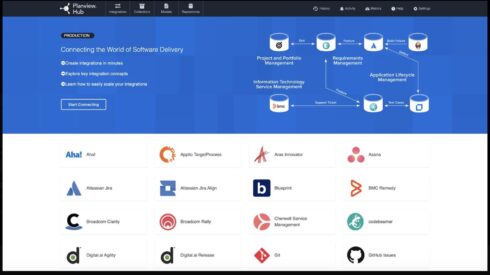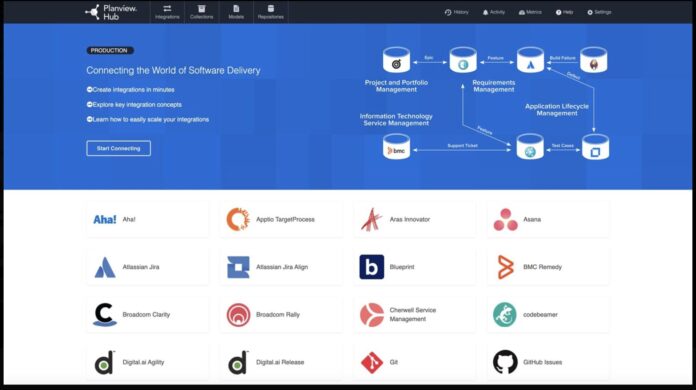
The value of tools integration and model-based integration was the subject of a recent SD Times Live! webinar with Jeff McCollum, vice president of product management at portfolio management platform provider Planview, and Giorgio Leon-Guerrero, a senior solution consultant.
This transcript was edited for length and clarity.
SDT: What are the key drivers for interest in integration solutions?
Jeff McCollum: There are four things that we usually cite when we talk about this. One is fidelity of work items across the tool chain. So just making sure that if you’re working in different systems, that the things that you’re working on, the description of a story or the description of a defect or feedback from a customer, that remains consistent across your entire tool chain. Next, it’s important to maintain a single system of record for analytics, which means allowing users to run queries on one integrated system to gather all necessary information for reports, rather than querying multiple systems. By doing this, you create a single source of truth for planning, work in progress, and results. By consolidating important information from various applications into one system, you enable stakeholders to see progress in their preferred tools. Finally, this reduces the time spent on duplicate data entry and switching between different applications.
SDT: Why is it important to allow different teams to work in different applications?
Jeff McCollum: Different people and groups work in different tools because those applications are best suited for the specific jobs they perform. For example, sales people shouldn’t work in Jira, and application developers shouldn’t work in Salesforce. If you have one team working in Salesforce, another one working in JIRA, another one working in Azure DevOps, another one working in tests, there may be information that’s contained within each of those tools that should be shared with others that are working in different applications. So you know, again, a multitude of tools is generally good because it allows specialization, but it comes with a certain drawback. Now that drawback can be overcome through integration, because it consolidates the necessary information into one application, aligning stakeholders to easily see progress in their preferred tool.
SDT: Can you give an example of a simple integration scenario?
Giorgio Leon-Guerrero: A simple scenario involves the integration of Azure DevOps (a popular application life cycle management tool) with ServiceNow. Using the Planview Hub allows support teams in ServiceNow and development teams in Azure DevOps to share information and see progress on collective work items.
SDT: What is the impact of integration, as opposed to switching tools?
Jeff McCollum: Research by Planview indicates that, on average, a person saves about eight minutes when going from entering data in one system to copying it into another and then returning to productivity. This is considered a conservative estimate, with some partners reporting 10-11 minutes saved. You could type something into Azure DevOps, then move over to ServiceNow and type something over there, and if there’s an update there, then you type it back into Azure DevOps, and so on. You probably do this some in your everyday life, and you think, ‘oh, that’s kind of annoying,’ and it takes a little time, but it’s not a really big deal. But a little time for hundreds of people over an entire year adds up to a lot of time. Every time that you would encounter a circumstance where you have to duplicate entry, entering the same information in multiple systems, that is wasted time.
SDT: What is “model-based integration” and how does it differ from “point-to-point integration”?
Jeff McCollum: Let’s say you have maybe five or six applications, Salesforce, ServiceNow, JIRA, Azure, DevOps, Zendesk, you want to connect them to share information. You would want to integrate Salesforce, ServiceNow, potentially Jira, maybe ADO, and instead of having to integrate each with all of the other ones, which would be a point-to-point integration, we have in Hub what we call model-based integration. What model-based integration is, if you want to think about it as you are integrating each application with Hub and then Hub with each application, that way you’re cutting down on these sorts of translation counts very substantially. It’s, in fact, literally exponential once you start expanding the number of applications that you’re involved with.
SDT: How does Planview Hub facilitate building integrations?
Giorgio Leon-Guerrero: When people start leveraging the system, we design very much a configurable approach to managing integrations within your environment, to be able to basically, in essence, create a portfolio of integrations. It allows organizations to connect to different systems, normalizes data even if systems behave differently, and provides pre-defined models with suggested common fields. Users can also input custom fields into the model. We’ve also encouraged people to leverage the ability to create traceability across the system, so they can see where their information is flowing from.
SDT: What is a “value stream architecture diagram” and why is it encouraged?
Jeff McCollum: A value stream architecture diagram outlines the flow of work within an organization, including the tools deployed, the information used in each tool, and how they interact. It helps in understanding business workflows, identifying areas for efficiency gains, automation, and process improvement through integration. It’s encouraged as a way to map out the flow of value in an organization.

